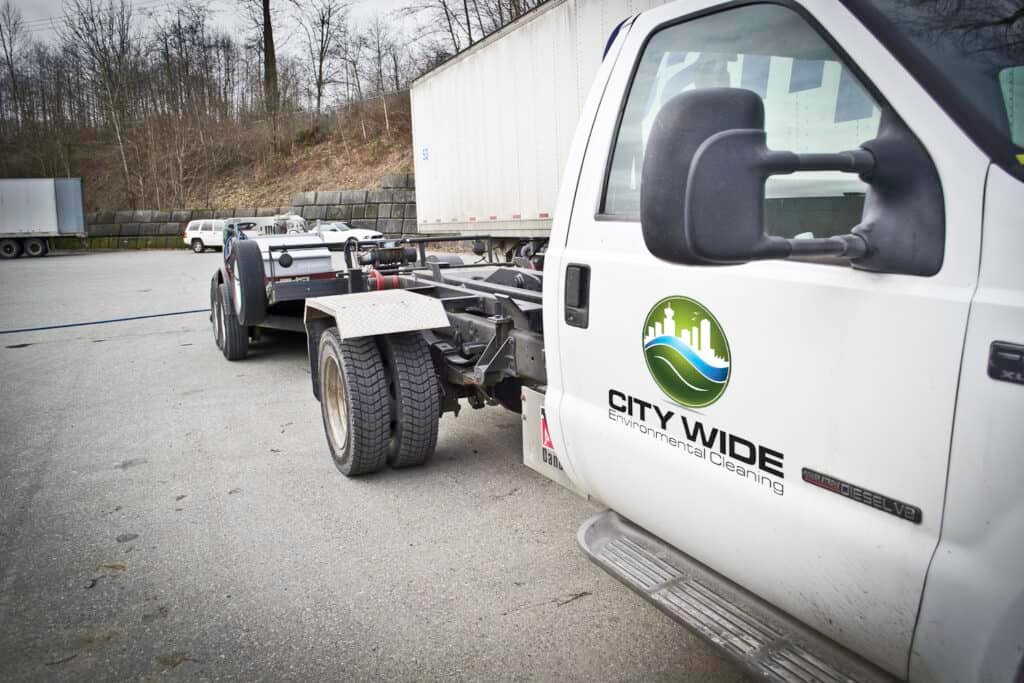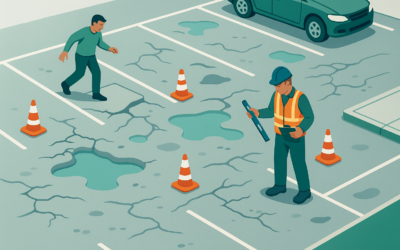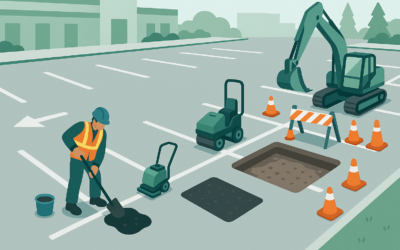As the mercury plummets and the pavement cracks and crumbles, drivers and homeowners face the all-too-familiar tableau of potholes peppering the roads and driveways. Enter cold patch asphalt—a convenient quick fix that promises a smooth drive without complex equipment or waiting for the perfect weather. This resourceful concoction allows for rapid repairs, cutting the need for professional help, and reducing the time the area is out of commission. It’s DIY-friendly and holds the fort until permanent fixes can be made, tackling emergency repairs with gusto. In this guide, we introduce you to cold patch asphalt, an essential player in the world of roadway quick fixes, explaining not only what it is but also how you can use it to take back control from those pesky potholes that threaten to disrupt your daily commute.
Table of Contents
When to Use Cold Patch Asphalt for Pothole Repairs
Assessing when to deploy cold patch asphalt is crucial to its effectiveness. Potholes are more than just an eyesore; they’re tire-trapping nuisances that can cause damage to vehicles and pose risks to pedestrians. The ideal candidate for a cold patch is a pothole that’s in a stable area where further deterioration is unlikely. If the pothole is actively expanding or the ground surrounding it is compromised, a cold patch might not take hold as firmly as it should.
Fun Fact: Did you know that cold patch asphalt was used in the early 1900s for railroad maintenance, taking advantage of its ease of use and storage?
The prime time for cold patching is typically during colder months or when immediate action is required. Even though cold patch asphalt can be applied in a wide range of temperatures and weather conditions, dry, slightly warm conditions are optimal. This repair method shines as a winter warrior, when regular hot mix asphalt plants are hibernating and immediate repair can prevent further damage from freeze-thaw cycles. Selecting the right moment for application goes a long way in ensuring the patch bonds well with the existing asphalt and provides a durable fix.
Key Takeaway: Cold patch asphalt is best used for stable potholes, in colder months, or when a quick repair is vital to safety and functionality.
Tools and Materials Needed for Cold Patching
The success of any DIY project lies in the prep work, and cold patching asphalt is no exception. To ensure you’re not caught off-guard halfway through, here’s a rundown of the tools and materials you’ll need:
- Protective gloves and eyewear for safety
- A stiff-bristled broom or a leaf blower for cleaning debris
- A tamper or a 4×4 wooden post to compact the patch
- Cold patch asphalt material — (you can find some at The Home Depot)
- A shovel or trowel for application
- Optional: Asphalt emulsion or primer for better adhesion
Each tool plays a pivotal part in ensuring that your pothole goes from a treacherous cavity to a nondescript part of your drive. Wear your protective gear to avoid contact with potentially irritating asphalt. Use the broom or leaf blower to purge the pothole of loose stones, dirt, and water—preparing a clean canvas for your masterpiece. And when the time comes to fill up that hole, the shovel, trowel, and tamp put the muscle into the mix, embedding the patch firmly into place for a finish that would make professionals nod in approval.
Key Takeaway: Having the right tools and safety gear at the ready ensures a smooth and safe cold patching experience.
Step-by-Step Guide to Cold Patching a Pothole
With the stage set and your tools by your side, it’s time to guide you through the nitty-gritty of cold patching a pothole:
- Start by rigorously cleaning the pothole. Remove all debris, water, and loose asphalt to ensure a solid base for the cold patch.
- Apply an optional adhesive primer to the dry pothole surface for enhanced bonding.
- Fill the pothole with cold patch material. Overfill it slightly, as the material will compact down.
- Spread the material evenly, ensuring it’s level with the surrounding surface.
- Compact the patch with your tamper or improvised compactor, applying even pressure across the surface.
- Inspect the patch to guarantee no low spots where water may pool. Add more material and compact as necessary.
- Allow traffic over the patch to further compact the material, or cover it with plywood and drive over it to finish.
After these steps, your pothole should now be a flat, unobtrusive part of the pavement. The patch requires no cure time, meaning the area is ready to use immediately—although a period of 24 hours is recommended for the best settling.
“Patience is bitter, but its fruit is sweet.” – Although you can drive on the patch right away, waiting a day can yield better results.
Tips and Tricks for a Successful Cold Patch
For those ready to tackle potholes like a seasoned pro, a few nuggets of wisdom can elevate your repair from good to great:
- Keep the cold patch material in a warm spot before using it for better workability.
- Apply the patch in layers if you’re dealing with a deep pothole, compacting each layer before adding the next.
- For heavy-traffic areas, consider using a vibratory plate compactor for a more solid bond.
- After compacting, if the edges seem like they might crumble, seal them with asphalt emulsion.
- Monitor the repaired area for a few days for any signs of sinking or shifting, and add more material if needed.
These tips can help you save on both time and material by doing it right the first time. Also, be mindful of the weather. Although cold patch asphalt is versatile, patches applied on dry, slightly warmer days often cure better and last longer.
Fun Fact: “An ounce of prevention is worth a pound of cure.” Maintaining your asphalt surfaces can help prevent potholes from forming in the first place!
The Life Span of Cold Patch Asphalt Repairs
Cold patch asphalt repairs don’t just provide a quick fix; they also bring decent longevity when applied correctly. However, many are curious as to how long they can expect their handiwork to last. While cold patch repairs are not meant to be as permanent as hot mix asphalt, they can hold up well for months or even years under the right conditions.
Several factors influence the lifespan of a cold patch repair. The quality of the cold patch material, the depth and size of the pothole, the amount of traffic, and even the local climate play roles in determining how your patch will fare over time. A repair in a quiet residential area may last significantly longer than one in a commercial zone with heavier vehicles rolling over it.
Key Takeaway: For the best longevity, ensure proper installation and consider the repair’s environment when assessing the life span of a cold patch asphalt repair.
An annual inspection can spot vulnerability before it becomes a headache, offering a chance for touch-ups. Regular maintenance, like sealing and proper drainage, also threads additional fortitude into your asphalt’s fabric, keeping it intact for the long haul.
Fun Fact: According to some estimates, there are about 55,000,000 potholes in North America—that’s a lot of potential cold patching!
Cost Considerations for Cold Patching
Fixing potholes can be an unexpected financial burden but understanding the costs involved with cold patch repairs can help you budget accordingly. The price of cold patch asphalt typically depends on the size of the pothole and the volume of material needed. The cost can range from a few dollars for minor do-it-yourself jobs to considerably more for larger areas requiring professional treatment.
Comparing the DIY route to hiring professionals, the DIY approach can be more cost-effective if you’re handling small repairs. The initial investment in the necessary tools might be worth it for the savings in labour costs. However, for extensive repairs or a series of potholes, professional services, while costlier upfront, may provide value with their expertise and efficiency.
Key Takeaway: Balance your cold patch repair approach between DIY and professional services based on the scope of the job and your budget.
When selecting cold patch materials, don’t compromise quality for price. Cheaper options might save you money initially but could end up costing more in the long run if they result in a shorter lifespan for the repair.
Fun Fact: Did you know that municipalities often allocate a substantial portion of their budget to road maintenance, including pothole repairs, due to the frequency and urgency of the issue?
Environmental Impact of Cold Patch Asphalt
With an increasing focus on sustainability, the environmental footprint of construction materials is under scrutiny. Cold patch asphalt generally has a lower environmental impact than its hot mix counterpart. The production of cold patch asphalt requires less energy as it is mixed at a lower temperature, reducing emissions and fuel consumption.
Moreover, the ability to apply cold patch asphalt in various weather conditions and store it for long periods helps minimize waste. Cold patch repair’s adaptability avoids the need for reheating and therefore the emission of additional pollutants. Proper disposal of unused material is also crucial, so it doesn’t end up contaminating the ecosystem.
Key Takeaway: Choose cold patch asphalt for a more environmentally conscious repair option, and always dispose of excess material responsibly.
It’s important to note that while cold patches are more eco-friendly than some alternatives, they aren’t entirely without impact. The extraction of raw materials and transportation of the finished product to the market still contribute to its carbon footprint. Efforts are ongoing in the industry to improve recyclability and reduce the use of non-renewable resources in asphalt production.
Fun Fact: Some cold patch asphalt products incorporate recycled materials like crumb rubber from tires, giving new life to waste products and further reducing environmental impact.
Alternatives to Cold Patch Asphalt
When it comes to pothole repairs, one size does not fit all. Cold patching, while convenient, might not be the ideal solution in every scenario. For those looking beyond cold patching, there are alternatives that could be better suited for certain situations.
Hot mix asphalt is the standard for durability and longevity but requires professional application. Infrared pothole repair is another method, offering more permanence by heating the existing asphalt and adding new asphalt mix. There’s also full-depth repair, involving the removal and replacement of affected pavement layers, best for systemic road issues.
Key Takeaway: Consider the extent of the damage, the desired longevity, and budget when looking at alternatives to cold patch asphalt.
Each method has its advantages, ranging from the ultimate longevity of hot mix applications to the cost-effectiveness and simplicity of cold patches. Your choice will depend on the repair’s required lifespan, the anticipated traffic, and, importantly, the budget at your disposal.
Fun Fact: Innovations in pothole repair technology are constantly being developed, including “self-healing” asphalts that use sun-activated chemicals to repair small cracks before they evolve into potholes.
Common Questions About Cold Patch Asphalt
Mysteries surround cold patch asphalt, breeding various questions regarding its use and capabilities. Some of these queries are fundamental in addressing concerns of the cold patch users and ensuring the effectiveness of their efforts.
One common wonderment is about the performance of cold patch asphalt in different climates, especially extreme ones. The unique composition of cold patch material enables it to withstand varied weather conditions, from scorching summers to freezing winters. This versatility makes it a go-to for emergency repairs in any season—but particularly in cold weather, when hot asphalt is not an option.
Another frequent question pertains to its load-bearing capacity. Can these quick fixes handle the weight of heavy trucks or only slight traffic from passenger vehicles? While not as robust as hot mix asphalt repairs, a well-compacted cold patch can support considerable weight and traffic, ideally serving light-to-moderate traffic areas.
Key Takeaway: Cold patch asphalt can tackle a range of climates and traffic, making it a versatile option for emergency repairs in various settings.
Other curiosities include the patch’s resistance to water and chemicals, the best practices for storing unused material, and the proper maintenance routines. Seeking answers to these questions arms users with knowledge, reducing uncertainty and paving the way for successful, lasting repairs.
Fun Fact: The Roman Empire built roads that lasted millennia, and while modern cold patch asphalt won’t last quite that long, with the right application, it can provide a surprisingly sturdy fix!
Let’s Get Patching!
Cold patching asphalt presents a reliable, cost-effective solution for dealing with the bane of drivers and maintenance crews alike—potholes. This guide has navigated you through essentials like when and how to apply cold patch, the tools you’ll need, and the steps to ensure your repair endures. Additionally, weighting cost considerations, environmental impact, and possible alternatives emphasized the value of informed decision-making in pothole repair.
With your newfound knowledge, you’re equipped to handle those crater-like nuisances promptly and efficiently. Remember that, while cold patching is not the be-all and end-all of asphalt repair, it’s a formidable ally to keep your roads and drivates passable until permanent repairs are feasible.
Cheers to your successful patching endeavours—may your drives be smooth and your potholes scarce!
FAQs
- Can cold patch asphalt be applied in the rain?While cold patch asphalt is designed to be versatile, for the best results, it’s recommended to apply it during dry conditions. However, if you’re in a pinch, some formulas are designed to be used even in wet conditions. Just make sure to remove as much water as possible from the pothole before application.
- How much traffic can a cold-patched pothole withstand?Cold patch repairs are suitable for light to moderate traffic conditions. However, if the repair is done correctly and the material is properly compacted, it can sometimes serve under heavier traffic, although the longevity of the repair might be compromised.
- Is it necessary to seal over a cold-patched area?Sealing over a cold patch is not mandatory, but it can help prevent water infiltration and extend the lifespan of the repair, especially in areas with heavy runoff or poor drainage.
- How do you know if you’ve added enough cold patch material?As a general rule, slightly overfill the pothole before compacting, as the material will settle. After compacting, the surface should be level with the surrounding pavement. If after compaction, there are any low spots, additional material may be needed.
- Can cold patch asphalt repairs be done in winter?Yes, one of the main benefits of cold patch asphalt is its ability to be applied during colder months when traditional hot mix asphalt cannot be used. Just ensure you clean out the snow or ice from the pothole before applying.
Get Your Potholes Patched Professionally With City Wide!
Driving through Metro Vancouver shouldn’t feel like an off-road adventure. City Wide is here to provide fast, efficient, and lasting pothole repairs. Our team of experts will ensure smooth, safe roads with professional-grade fixes.
Schedule a Repair or call us at (604) 836-5156 – let’s get those potholes patched!








